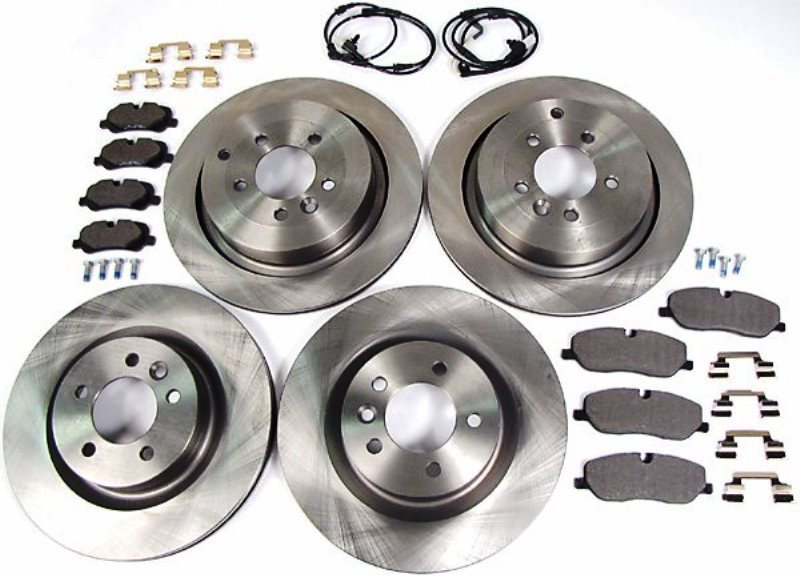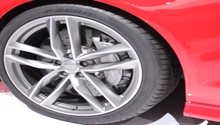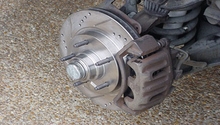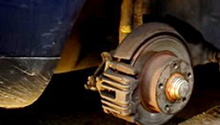Audi A6 C6: Brake Pad/Rotor Life and Replacement Cost
The brake pads and rotors are wear items, but what is normal and how much are the replacements? Read on to learn more about your brake pads and rotors.
This article applies to the Audi A6 C6 (2007-2016).
The modern brake system is just a complicated modernized version of how Fred Flintstone stopped his car, well, maybe a little different, but the idea is the same. After getting past all the pressure, hoses, brake fluid, and calipers, stopping the car comes down to friction between the pads and rotors. There are many questions that rise when it comes to brake pad and rotor replacement intervals, and what it is going to cost to replace them. This article will help you understand more about the brake pads and rotors in the Audi A6.

Brake Pads

Expected Longevity
Friction between the pads and the rotors is what slows down, and eventually stops, the car. The harder you step on the brake pedal, the tighter the pads will clamp on the rotors, and the quicker your car will stop. The average life of the original factory brake pads is 30,000 miles. This can vary depending on your driving style, especially is you're heavy footed. The A6 is equipped with sensors designed to let you know when your pads get too thin. If you want to use your pads to their full potentials, don't ride the brake and stop quickly. Slowing with the brakes slightly applied over a longer distance actually wears them faster than a quick stab of the pedal.
Types of Pads
There are various types of brake pads for your Audi: some with better initial bite, some with longer life expectancy, and some made for less dust on your rims. The stock pads are well built and they do the job well, quietly as well as effectively, but they can be improved upon for not much more cost. One of the best features of the factory friction material is that it does not cause much wear on the rotors over their life. The aftermarket options are numerous, and you can mix and match desired characteristics depending on your budget and interest. Rear more about various popular brands in the article: Brake Pad Reviews.
Cost of Pads
The cost of brake pads and having them replaced can vary depending on the brand, function, and whether you're replacing them yourself or having a dealership do the job. The average cost for just a set of brake pads for the front or back brakes is $50 per axle. This can decrease with the lower quality pads, and they can easily increase with high performance aftermarket pads. If you're about to go to your dealership for a four wheel brake job, expect to pay upwards of $1,200 for everything.
Brake Rotors

Expected Longevity
The brake rotors, unlike the pads, can last up to 100,000 miles; however, this also depends on your driving style and choice of brake pads. The recommended replacement for the rotors is every third brake pad replacement. Again, this can vary depending on how hard you use your brakes, and more importantly, how long you wait before you replace your brake pads. All it takes is a few dozen miles of stopping with pads worn down to the metal backing plate to make a set of rotors unusable. Audi and your dealer may try to replace the disc rotors as part of the brake job, but any independent shop will likely just grind them flat again and take off a few thousandths of an inch off the surface.
Types of Rotors
The typical brake rotor on your Audi, if it's stock, is a smooth internally ventilated type. This type works well enough and lasts the longest, but it lacks some of the extra bite and heat dispersion properties of the other types. Slotted rotors have some grooves, an average of six grooved lines, designed to allow built up gases to escape easier, which keep the rotors cleaner, cooler, and gives better initial stopping bite. Cross drilled rotors have holes in them, which like the previous type, allows gases to escape, as well as allow air to go through the rotors, thus cooling it down. The cooler your pads and rotors, the better stopping power you get, and the longer they last. You can pay a little extra to combine the last two types and get the drilled and slotted type, which is designed for ultimate performance. It should be noted, though, that many times the holes or slots can provide places for stress to build up and cracks to start.
Cost of Rotors
The average cost of OEM rotors is $100 each, which is actually much less than the aftermarket performance ones. The fancy aftermarket rotors can run $400 for the pair, and that's not even the most expensive ones. Of course, there are less expensive than OEM stock solid rotors as well. Replacing the rotors yourself can save you $600, which is what the dealership would charge for labor, add the parts to that, and you have yourself a $1,000 bill at the least. Replacing the rotors is as simple as removing the wheels and getting the caliper out of the way.
Related Discussions and Article
- Changing Rotors - AudWorld
- Rotors Cost - AudiWorld
- Pads' Cost - AudiWorld
- How to Replace Brake Pads/Calipers/Rotors - AudiWorld






